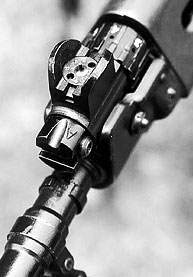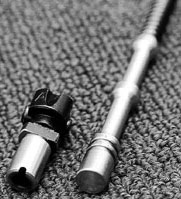|
 |
| Above: The FN gas plug as it should be. Note the tactile grove and A (Automatic). If you cannot see this, your gas plug is upside down! |
Remove the piston, unscrew and remove the handguards and loosen the gas regulator. No further disassembly is recommended, nor should any more be necessary for routine cleaning. Re-assembly is, of course, the reverse of the foregoing. One little tip - when putting the gas plug back into place, ensure that the letter “A” is uppermost (or that the grooved surface is up, depending on the model). If the ungrooved surface (or letter “G”) is visible, all gas supply is cut off from the piston and the rifle will not cycle. The gas plug is only placed in this position when one wishes to launch rifle grenades, which I would hope none of you are planning on doing! Another re-assembly tip is to point the rifle down when replacing the bolt and carrier. Please note that all the aforementioned field stripping and assembly steps can be carried out with the safety catch in the “safe” (uppermost) position.
 |
| Above: The FN gas plug and piston. Keep them clean but not oiled. |
A word now on the cleaning and lubrication of your rifle while it is field stripped. You will, of course, remove all powder fouling and specks of brass casing wherever visible, and clean the barrel as you would any conventional rifle (not forgetting the chamber). The gas tube will also have to be cleaned, and this is best done with an appropriately sized brush with soft bristles. A .45 calibre brush works fine. Follow this up with a cleaning patch on a pistol rod. A word of warning here - when using cleaning patches in the gas tube, especially on a pull-through, don't be tempted to use too large a patch. The very first time I ever cleaned an FN rifle I managed to get a too-large cleaning patch stuck in the gas tube. This got me into an awful lot of trouble, necessitating me pushing a Land Rover uphill by myself. This reinforced the lesson like you wouldnít believe, so donít you go and do it, OK ? You will notice that after firing the piston is covered in a hard, dark grey residue which is difficult to remove.
Recipes abound for the best way of removing this gunk, but the easiest way I have found is to use a square of green pot scouring material. Avoid the use of harsh abrasives (like sand, for one) and be very careful of strong acids. These can seriously corrode the piston and tube. Lubricate the bolt and carrier sparingly along the rails and sliding surfaces, and ensure that the gas regulator can be turned by hand. If it canít, unscrew it and clean it. Now a word of advice on lubricating the piston and tube. Donít. The piston and tube are subjected to repeated blasts of gas at high temperature and pressure when fired, and oil will merely bake on and add to the fouling. Damage can also result to the gas tube, depending on the type of oil used.
Under great pressure, many oils exhibit a phenomenon known as “dieselling”, which is basically detonation. This adds to the pressures within the port, and will contribute to cracking of the gas tube. Such a crack occurs across the threaded portion of the tube, and the rifle will not cycle no matter what. Many old FN rifles are found with cracked gas tubes, and I am convinced that the main culprit is oil on the piston and in the tube. Another word of warning - there is a fair amount of corrosively primed 7.62mm NATO military ball ammunition floating around. If you use such ammunition, you will have to take the additional cleaning steps of flushing the barrel and gas tube out with boiling water, making sure that you thoroughly dry them afterwards. The bore of the FN is chrome plated to resist corrosion and wear, but I have not found such plating to be an absolute preventative against the ravages of corrosive priming.
|